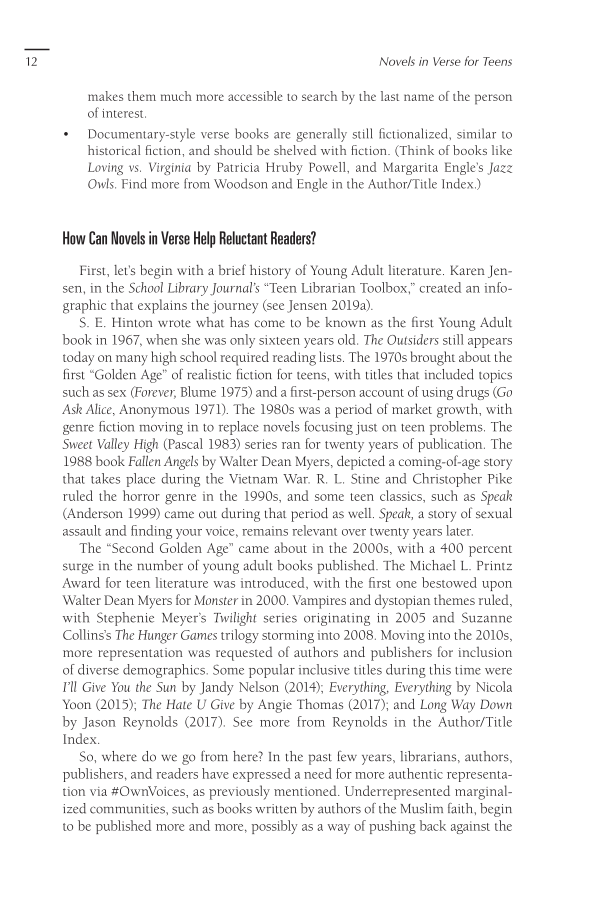12 Novels in Verse for Teens makes them much more accessible to search by the last name of the person of interest. • Documentary-style verse books are generally still fictionalized, similar to historical fiction, and should be shelved with fiction. (Think of books like Loving vs. Virginia by Patricia Hruby Powell, and Margarita Engle’s Jazz Owls. Find more from Woodson and Engle in the Author/Title Index.) How Can Novels in Verse Help Reluctant Readers? First, let’s begin with a brief history of Young Adult literature. Karen Jen- sen, in the School Library Journal’s “Teen Librarian Toolbox,” created an info- graphic that explains the journey (see Jensen 2019a). S. E. Hinton wrote what has come to be known as the first Young Adult book in 1967, when she was only sixteen years old. The Outsiders still appears today on many high school required reading lists. The 1970s brought about the first “Golden Age” of realistic fiction for teens, with titles that included topics such as sex (Forever, Blume 1975) and a first-person account of using drugs (Go Ask Alice, Anonymous 1971). The 1980s was a period of market growth, with genre fiction moving in to replace novels focusing just on teen problems. The Sweet Valley High (Pascal 1983) series ran for twenty years of publication. The 1988 book Fallen Angels by Walter Dean Myers, depicted a coming-of-age story that takes place during the Vietnam War. R. L. Stine and Christopher Pike ruled the horror genre in the 1990s, and some teen classics, such as Speak (Anderson 1999) came out during that period as well. Speak, a story of sexual assault and finding your voice, remains relevant over twenty years later. The “Second Golden Age” came about in the 2000s, with a 400 percent surge in the number of young adult books published. The Michael L. Printz Award for teen literature was introduced, with the first one bestowed upon Walter Dean Myers for Monster in 2000. Vampires and dystopian themes ruled, with Stephenie Meyer’s Twilight series originating in 2005 and Suzanne Collins’s The Hunger Games trilogy storming into 2008. Moving into the 2010s, more representation was requested of authors and publishers for inclusion of diverse demographics. Some popular inclusive titles during this time were I’ll Give You the Sun by Jandy Nelson (2014) Everything, Everything by Nicola Yoon (2015) The Hate U Give by Angie Thomas (2017) and Long Way Down by Jason Reynolds (2017). See more from Reynolds in the Author/Title Index. So, where do we go from here? In the past few years, librarians, authors, publishers, and readers have expressed a need for more authentic representa tion via #OwnVoices, as previously mentioned. Underrepresented marginal- ized communities, such as books written by authors of the Muslim faith, begin to be published more and more, possibly as a way of pushing back against the
Document Details My Account Print multiple pages
Print
You have printed 0 times in the last 24 hours.
Your print count will reset on at .
You may print 0 more time(s) before then.
You may print a maximum of 0 pages at a time.





































































































































































